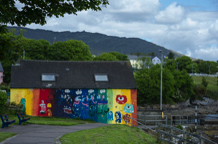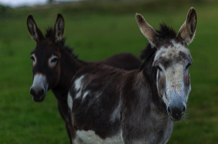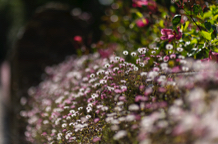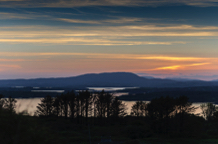I set off for my holiday in west Cork in summer 2015 armed with a pair of 1967 Nikon F bodies, one with a NIKKOR 35mm f/2 and one with a NIKKOR 50mm f/1.4 lens fitted, and ten rolls of Kodak colour negative film. I was buoyed up with the knowledge that going back to film was a sure-fire way of slowing down the frenetic pace of modern photography.
I savoured the familiar feel of my old Nikons, forgotten for many years as I raced from Fs and F2s and thence to Nikon F4s and F5s before converting to digital twelve years ago. Like old cars they smelt different and had a reassuringly solid heft in the hand. The brass showed through the black enamel in places, evidence of hard use. The original Nikon leather straps, whilst thin by modern standards, proved ideal to bear the weight of bodies with short lenses fitted.
I didn’t take any sort of meter with me, partly because I wanted to be unencumbered but mainly because I wanted to prove that I could still judge exposures to a high degree of accuracy. Before leaving I ‘calibrated’ my eyes against a meter and found that I was still within half a stop - which was reassuring. One of the first things that I learnt as a young photographer was how to judge distance and how to judge the light. It was drummed into me by my first boss that to be ready for anything one had to have the lens preset to around twelve feet and have a constant eye on the light, readjusting the camera settings as the light changed. I found that I could still do this after 45 years, with over twenty years of using autofocus cameras and built-in meters failing to block out the old core values.
Loading the cameras was an easy job with that gorgeous smell of new film emulsion filling the still air. It brought back many great memories as only aromas can do. Real leather camera straps and cardboard film boxes all had their scents then as a total part of photography. I felt comfortable with these old friends and found that I was really looking forward to shooting at a different pace. The last time I had shot any sort of film was in early 2006 when a client insisted that only film could achieve the results that he desired. This was conveniently overlooked when he chose the digital files that I shot alongside the film. That was it for me - the end of an era that started for me with my Kodak Box Brownie in the early 60s.
I found that I still had an alarming number of rolls of transparency film lurking about the place, but I thought that perhaps I should shoot colour negative this time. I could get good black and whites if I wanted, the exposure latitude was reasonable if, for some reason, my personal calibration failed and I could also get them scanned as part of the whole package. There’s just no escape from the digital element any more.
All the elements were in place for a truly memorable time.
However, after a day I realised exactly why I had relinquished my hold on film. Having to plan my life around blocks of 36 exposures was a pain. Always having slow film in the body as the light started fading, meaning that one had to make the choice of either sacrificing the remaining frames (always more than half a roll in my experience) and reloading with a faster film, or having a spare body loaded with faster stock ready to hand.
I revisited the worrying stage of getting near the end of a roll of film and then wondering if the next sequence would require five or 25 frames. Always sacrificing film was a constant drain on a photographer in those days. I look back now at the thousands of rolls of film that I have archived and realise that so many have great lengths of unexposed stock at the end. What a waste and what a cost.
Even taking a mere ten rolls of boxed film with me illustrated the space that had to be put aside for these bulky items. I remember reusing 35mm slide boxes that Kodachromes were returned in to fit four cassettes of ready-use film. This reduced the space requirements, but taking 50 or so rolls of film each time I went off somewhere meant that I had to spend £400 or so on stock and then around the same amount again to process it. Well today £800 will buy you a great digital camera kit, or a good secondhand NIKKOR 85mm f/1.4 lens or a laptop (not a MacBook Pro obviously), so why on earth would any sane photographer want to spend this sort of money?
And of course that’s only half the story. Rolls of film need to be printed or scanned before they can actually be of any real use. Colour transparency film, long the professional standard when repro was required, had to be scanned at some stage in its life if it was to be reproduced. Either the client did it using an alarmingly expensive high-end scanner like a Howtek Scanmaster at more than £100k or, increasingly, we bought desktop scanners from the Nikon or Flextight ranges at more modest prices. Scanning takes time and skill - a great deal of each. Even then the image is not ready to be sent to a client as it has to be retouched, graded, colour balanced, profiled and captioned.
Suddenly the photographer had to become the master of other new skills if he or she was to sell material. Being a photographer has evolved from merely taking some shots, devving the film and producing ten by eight glossies to becoming a digital lab technician working with expensive kit in a high pressure environment. Why on earth would you want to go back to film, when shooting digital means that the client can have the images relatively quickly and with far less pain for us?
To coin that old favourite, nostalgia isn’t what it used to be. The more film that I shot on my Irish trip - and I didn’t shoot very much I confess - the more that I longed for digital. After a couple of days I couldn’t think of one good reason why anyone in their right mind would want to shoot with film.
Many photographers seem to have lost sight of the reason why they are shooting pictures. Surely it’s only the end result that matters - the final image? The route that we take to get there is irrelevant. Young photographers can learn so much more quickly if they use the modern cheap equivalent of Polaroid to assess their progress. Experienced photographers can now spend so much more time creating and testing - and playing - with images to get just what they want, without it costing a penny. What can possibly be better than that?
Surely we express pleasure and delight in most forms of progress? Who would want to walk to the bottom of their garden on a freezing winter night to use the outside toilet? Who would want to check their distributor cap every week and grease their suspension points every month in their car? Who would say that there is nothing to beat VHS tapes, or gramophone records or chunky 12” CRT monitors?
There will always be those who relish the old days - until they actually have to live in them! Look at the plethora of TV programmes that hark back to the delights of the Edwardian Farm, the Victorian Hospital or the Iron Age Village to realise that we love to look back whilst wearing a smug grin of satisfaction on our faces, but living that life again - never!
Photography has progressed and whilst I am happy to keep reminders of my life on the shelf, gathering dust, I now find that I am quite content to leave them there as I’ve moved on. My children will look at them in 20 years time when I’m gone and wonder what on earth it was all about. If any reader wants to buy some of my old Nikons, I'm no longer attached to them as I once was - make me an offer.
And what about my shots from Ireland? Well, the local processing lab completely ruined them by using out-of-date chemicals. Luckily I also packed a Nikon D3S and two lenses as well - just in case!
20151111
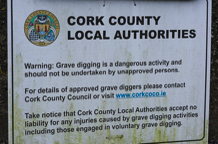
An Appreciation Of Film - Never Again!
